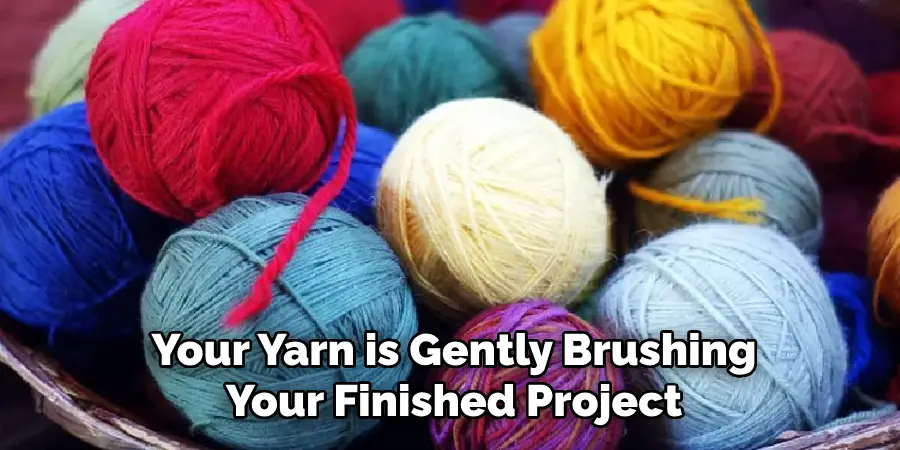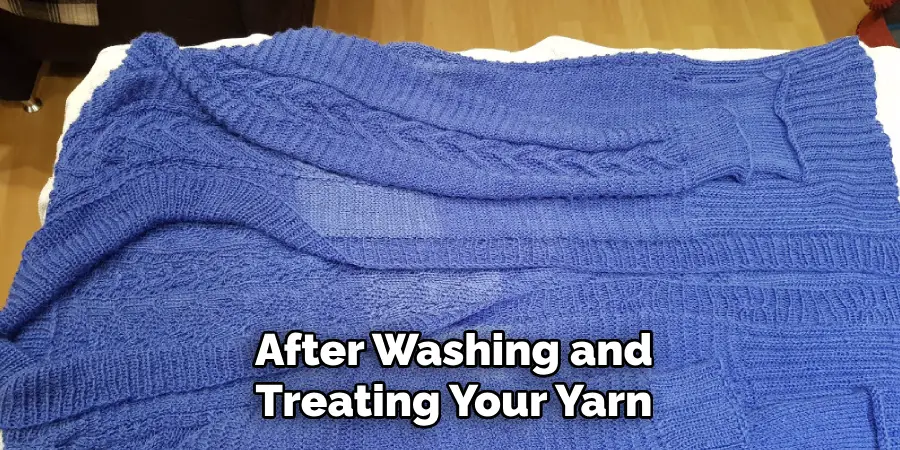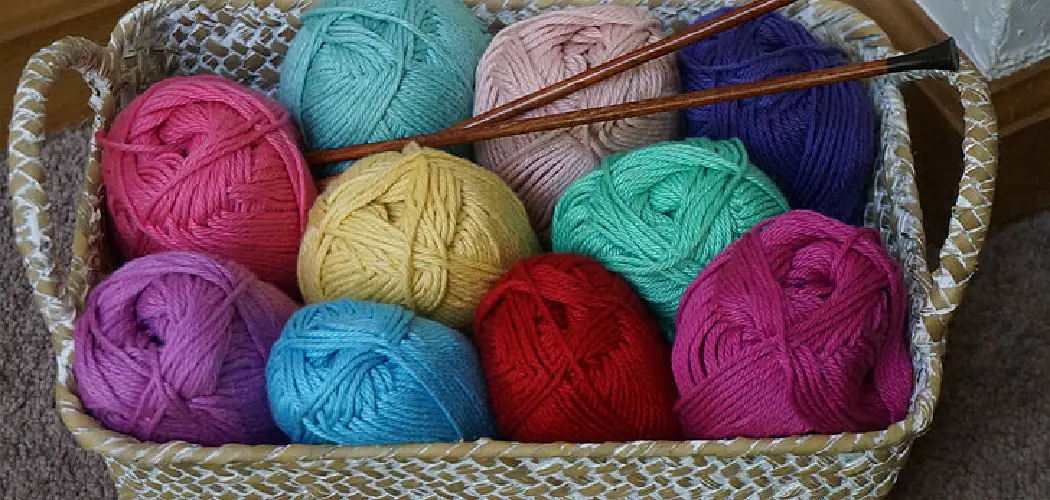Growing up, one of my fondest memories was spending weekends at my grandmother’s house, where I would watch her sit for hours by the window, knitting projects big and small. I was always amazed by how quickly her wooden knitting needles would blur as they worked the thick wool yarn into beautiful scarves, hats, sweaters – whatever she felt inspired to create that day.

As a young girl, I couldn’t wait to join her in the craft. But when I first tried to knit with her yarn, I couldn’t believe how scratchy and unpleasant it felt against my skin. The thick wool fibers seemed to catch and tug uncomfortably no matter how gently I tried to maneuver the needles. Needless to say, my early knitting attempts were less than enjoyable.
But don’t worry! In this post, I’ll share how to make yarn softer for any knitting or crocheting project.
What Will You Need?
Before we dive into the steps to make yarn softer, let’s gather our materials. You’ll need:
- A sink or basin large enough to hold your yarn
- Gentle soap or wool wash (available at craft stores)
- A soft towel
Let’s get started!
10 Easy Steps on How to Make Yarn Softer
Step 1. Use a Fabric Softener
One of the easiest ways to make yarn softer is using a fabric softener. Add a small amount of liquid fabric softener to a bowl of warm water and let the wool soak for 10-15 minutes. Then, rinse the yarn with cool water and gently squeeze out any excess water before laying it flat to dry.
Step 2. Try a Vinegar Soak
Another method for softening yarn is by using a vinegar soak. Mix one cup of white vinegar with four cups of hot water in a large bowl or bucket. Submerge the thread in the mixture and let it sit for 30 minutes to an hour. Rinse the yarn with cool water and gently squeeze out any excess water before laying it flat to dry.

Step 3. Use a Hair Conditioner
A hair conditioner can also be used to soften yarn. Mix one part hair conditioner with two parts warm water in a large bowl or bucket. Place the thread in the mixture and let it sit for 10-15 minutes before rinsing with cool water and gently squeezing out any excess water. Lay the yarn flat to dry, being careful not to stretch or pull on it too much.
Step 4. Avoid Harsh Chemicals
When washing your finished project, avoid using harsh chemicals such as bleach or heavy-duty detergents, as they can strip away natural oils from the yarn, making it rougher and less soft. Instead, opt for gentle detergents specifically made for delicate fabrics. As a general rule, use half the recommended amount to prevent residue build-up.
Step 5. Use Wool Wash or Lanolin Spray
For natural fibers such as wool, alpaca, or cashmere, specialized products like wool wash or lanolin spray can help soften and maintain their softness over time. These products contain natural oils that can replenish the moisture in your yarn without stripping away its natural properties. Be careful to follow the instructions on the development and avoid using too much, as it can make your yarn feel greasy.
Step 6. Block Your Project
Blocking is an essential step in knitting or crocheting projects that can also help soften yarn. After washing and gently squeezing out excess water, lay your project flat and shape it to the desired size. Let it dry completely before removing it from the blocking surface, and you’ll notice that your yarn is much softer and more pliable.
Step 7. Steam Your Finished Project
If you find your finished project still too stiff or scratchy, try steaming it. You can do this with a steam iron or a garment steamer, but remember not to touch the yarn directly with the iron. The heat and moisture from the steam can relax the fibers, making your yarn softer and more comfortable to wear. Always remember to test a small, inconspicuous area first to ensure that the steam won’t harm the tale.
Step 8. Brush Your Finished Project
Another technique to help soften your yarn is gently brushing your finished project. This is particularly effective with animal fiber yarns such as wool and alpaca. Use a soft-bristled brush and gently brush along the direction of the yarn, being careful not to pull or snag the fibers.

This process can help separate the fibers, making them fluff up and feel softer to the touch. Be cautious not to overdo this step to avoid causing a fuzzy appearance.
Step 9. Tumble Dry with Care
If your yarn is made from a durable material such as cotton, it might stand up to a quick tumble in the dryer.
However, use a low setting to prevent shrinkage or damage. You can also add a couple of clean tennis balls or dryer balls to the drum, which will help soften the yarn as they bounce around. Just remember to check the yarn’s care instructions first, as not all fibers can withstand the heat and tumbling of a dryer.
Step 10. Use a Fabric Shaver
Lastly, consider using a fabric shaver for yarn that has been knitted or crocheted into a garment or item. This device can gently remove pilling and loosen up the fibers, making the yarn feel softer. It’s essential to proceed cautiously when using a fabric shaver to prevent damaging the yarn or finished item. Start with a small, inconspicuous area and work slowly to ensure the best results.
By following these ten easy steps, you’ll be able to make any yarn softer and more enjoyable to work with.
5 Additional Tips and Tricks
- Keep It Gentle: Making yarn softer can be time-consuming, but it’s important to remember that being gentle is key. Avoid harsh chemicals or vigorous scrubbing as this can cause damage or breakage in the fibers of your yarn.
- Try a Different Washing Method: If you’ve used the same method for all your yarn projects, it may be time to switch things up. Different yarns may require different washing methods, so research and experiment with gentle handwashing or using the delicate cycle on your washing machine.
- Check the Water Temperature: The water temperature can significantly affect how soft your yarn turns out. Warm or slightly hot water can help open the fibers and allow them to absorb more conditioner, resulting in softer yarn.
- Apply Heat: Steam can help to soften yarn. After washing, place the thread in a steam basket over boiling water for a few minutes, but be sure to avoid direct contact with the water.
- Air Dry: After washing and treating your yarn, allow it to air dry. This method is gentler than machine drying and can help maintain the yarn’s new soft texture.

With these additional tips and tricks, you’ll be on your way to making even the roughest yarn feel soft and luxurious.
5 Things You Should Avoid
- Avoid High Heat: High heat can shrink or damage the fibers in your yarn, making it more difficult to achieve a soft texture. Always use low to moderate heat when washing or drying your yarn.
- Avoid Strong Detergents: Strong detergents or bleach can damage yarn fibers, especially if the yarn is delicate or natural. Opt for gentler, fabric-friendly soaps instead.
- Don’t Wring Out Your Yarn: Resist the temptation to wring out your yarn after washing. This can cause damage and increase breakage, resulting in a rougher texture.
- Avoid Rushing the Process: Making yarn softer is not a quick process. It can take time for the yarn to absorb the conditioner or for the fibers to loosen up. Rushing the process can lead to damage.
- Don’t Skip the Rinse: After conditioning your yarn, ensure you rinse it thoroughly. If conditioner is left in the yarn, it can make it feel greasy or heavy instead of soft and light.
By avoiding these common mistakes, you’ll be able to achieve soft and luscious yarn every time. Remember always to take your time and handle the yarn gently during the washing and drying process.

Conclusion
In conclusion, learning how to make yarn softer is an essential skill for any knitter or crocheter. Whether you prefer natural fibers or synthetic blends, various techniques and tips can take your yarn from rough and scratchy to smooth and luxurious. From using conditioner to applying steam, we have explored multiple methods that will suit your needs and preferences. So go ahead and give them a try!
Experiment with different types of yarn and see what works best for you. Read the label and conduct a test swatch before diving into your project. And remember the importance of proper care for your finished pieces to maintain their softness over time.
As you continue on your fiber journey, remember that having softer yarn not only enhances the overall look and feel of your creations but also adds to the enjoyment of working with them.
So don’t let rough yarn hold you back from unleashing your creativity – use these tips and techniques to make every project a delight for both the maker and the receiver. Happy crafting!
Expertise:
Crafting expert with a focus on innovative techniques and diverse materials.
Specialization:
- Textile arts (weaving, embroidery, and fabric dyeing)
- Woodworking and furniture design
- Mixed media and upcycling projects
Recognition:
- Featured in local art exhibits showcasing innovative craft projects
- Collaborated with community organizations to promote crafting workshops
- Received accolades for contributions to sustainable crafting initiatives
Mission:
- To inspire and empower crafters of all levels to discover their creative potential
- Encourages experimentation and self-expression through hands-on projects

